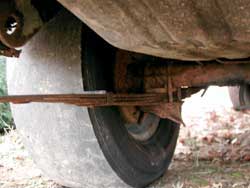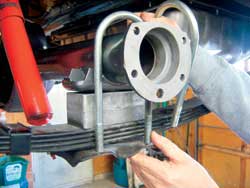Early Mustang Suspension 101
By John Brooks
Few will argue the '65-66 Ford Mustang Fastback is a gorgeous car. Its long hood, short rear deck, and the graceful, sweeping curve of the roofline are representative of classic automotive form.
It was a winner from the start, benefiting from the sleek, sporty design that's carried over through the Mustang's 40th birthday. With numerous power and appearance upgrades, the car was sure to be a hit...then and now.
However, driving a vintage Mustang today leaves something to be desired. The sleek design is handicapped with a power-robbing suspension that was borrowed from its humble cousin, the Ford Falcon. Hampered with too much ride height, poor shocks and springs, narrow wheels and tires, and weak drum brakes, the early Mustang was simply not a winner when it came to handling and performance, especially by today's standards.
Automotive technology has advanced significantly since the Mustang's debut. Today's vehicles start, run, handle, and perform better than anything Detroit produced 40 years ago. Cars are safer through modern suspension and braking systems. Performance numbers routinely top 200 horsepower from only four cylinders. Plain and simple, the classic Mustang is 40-year-old technology and behaves like 40-year-old technology. It's difficult to maintain, requires frequent repair, and on its best day does not perform as well as a modern family sedan.
G-Force Design Concepts decided to take a solid '66 Fastback rolling chassis and make it into a great car for today, by following form with function. The goal was to combine the form of the classic Mustang with the function of modern automotive technology.
We began disassembly of our project car by removing all but the unibody shell. The first step in the overall project was to build a solid foundation - a suspension system that will provide great handling and performance, while enhancing both the safety and appearance of our vintage fastback. Of course affordability was also a factor.
The most important step is to set a goal for the project, and ensure all of the components support the goals of the finished vehicle. Any component that doesn't support the design goal is wasted, or worse, detracts from the car's performance. This Mustang is a Pro-Touring project with a suspension system capable of handling the duties of everyday performance driving, combined with an aggressive stance and increased safety and reliability.
The goal was to increase suspension performance through a combination of improved bolt-on parts, strategic strengthening of chassis components known to flex, and a lowering of the car's center of gravity for improved handling. The car's ability to corner would be improved through the addition of larger-diameter anti-sway bars, polyurethane bushings, and the addition of a teamed coil/shock package to better hold the road. Modern tires and brakes were also part of the game plan, and the additional performance provided by these modern parts would work in concert with the other suspension upgrades. We were trying to avoid costly fabrication and re-engineering of the complete suspension system, choosing instead to research the aftermarket and come up with a balanced package to address this particular car. Should you be building a street machine of your own, these are the precise points you should be going over as you plan the project. Balancing the available budget, keeping in mind the project's final goal, and prioritizing the car's needs were all part of this Mustang's grand plan. By keeping all three points in perspective, the final results were more than satisfactory.

Before
Here we see the Mustang's original rear suspension. The worn out stock leaf springs were never designed for high performance. Rather, they were engineered to provide a smooth ride by mid-'60s standards. We will replace them with a pair of stiffer leaf springs designed for greater performance. The new springs will bolt in directly where the original springs are. We'll also add performance shock absorbers as part of the rebuild.

After
We chose to use lowering blocks between the 9-inch axle's spring seats and the springs to lower the rear of our Mustang about 1-inch. New stock rear spring shackles and U-bolts were used. First, the springs were attached at the front frame mount and then placed into the rear shackles. Once the bolts were snug, we tightened the U-bolts at the axles and then re-checked all bolts, torquing them to specifications.
We removed the old, worn-out rear shocks and replaced them with Koni Vintage Red units. First, remove the plugs from the rear floor to access the upper bolts. Ours were easy to locate, since the interior had been removed. Once the upper and lower bolts are removed, the old shocks are replaced with the new Konis. The "Vintage Red" shocks do a wonderful job of dressing up the suspension.
View all '65-'66 Mustangs in the vehicle registry!
Note: SuperMotors has a business affiliation with Street Thunder Magazine, which provides street rod and automotive content to SuperMotors.
Back to the Issue #2 index.